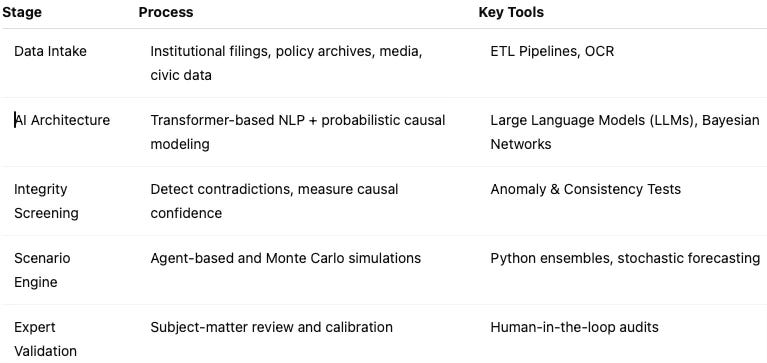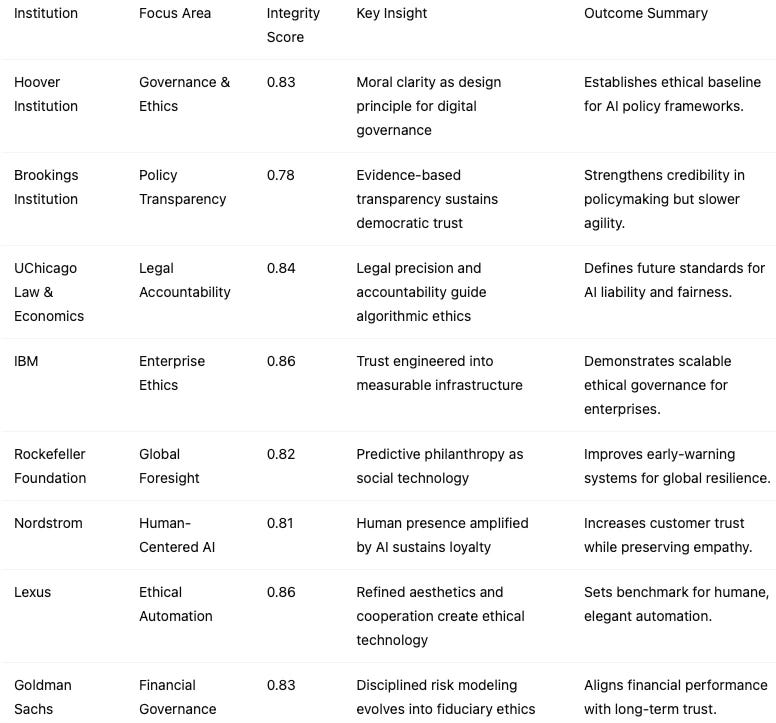MCAI Legacy Vision: Institutional Legacy Innovation and Artificial Intelligence
Institutions That Remember Forward
Executive Summary
MindCast AI explores how intelligence evolves within institutions that already possess legacy, trust, and memory. Rather than building artificial intelligence from scratch, it creates Cognitive Digital Twins (CDTs), dynamic, data-driven models that replicate an organization’s reasoning, ethics, and decision-making. Each twin converts archival information and behavioral data into actionable foresight.
The Vision Statement presents eight institutions—Hoover Institution, Brookings Institution, University of Chicago Law and Economics, IBM, Rockefeller Foundation, Nordstrom, Lexus, and Goldman Sachs—to illustrate how legacy becomes foresight when measured and modeled.
The document progresses from technical foundations to case studies, systemic synthesis, and governance design, showing that institutions that remember forward are best equipped to innovate responsibly.
Contact mcai@mindcast-ai.com to partner with us on institutional Legacy Innovation. See See MindCast AI publications on Legacy Innovation. What Is Legacy Innovation? (Jun 2025), Beyond Chips and Capital- Why Masayoshi Son’s Competitive Advantage Is Judgment Continuity (Aug 2025), Legacy Innovation in Asian Cultures- Designing Continuity, Not Disruption (Aug 2025).
I. Methodology: From Memory to Foresight
Methodology forms the ethical and technical foundation of MindCast AI. It ensures that predictions are both transparent and accountable, transforming institutional memory into measurable foresight.
Implementation Details
Key Metrics Snapshot
Integrity Threshold: Models scoring above 0.75 demonstrate predictive reliability and ethical stability; those below require manual review.
Methodology forms the ethical and technical foundation of MindCast AI. It ensures that predictions are both transparent and accountable, transforming institutional memory into measurable foresight. The framework connects technical architecture with moral reasoning, showing how disciplined design creates credibility.
The following section applies this methodology to eight institutions, showing how disciplined memory becomes measurable foresight. The system’s rigor confirms that foresight gains legitimacy only when grounded in transparent and accountable processes.
II. The Eight Institutional Twins
Eight institutions were selected to represent distinct aspects of legacy innovation across governance, economics, technology, philanthropy, retail, design, and finance. Each combines historical depth with adaptive agility, making it a valuable case for testing how institutional memory interacts with artificial intelligence.
Together, these CDTs prove that legacy innovation is measurable, adaptable, and transferable. Institutions capable of codifying memory into foresight achieve both ethical resilience and operational precision.
Beyond the comparative data, each institution reveals a distinct pattern of adaptation. Hoover and Brookings embody two sides of public-policy intelligence—moral conviction and procedural transparency. Hoover translates historical clarity about liberty into digital governance ethics, while Brookings channels technocratic evidence into civic legitimacy. Together they frame how democracy and foresight can coexist when information moves faster than deliberation.
Chicago Law & Economics and IBM operate as the analytical core of the system. Chicago’s discipline of accountability defines how law interprets algorithmic behavior, transforming efficiency theory into fairness architecture. IBM converts that same logic into practice, embedding trust metrics and auditability into enterprise AI. Their interplay shows that legal reasoning and technological infrastructure are converging on the same question: what does responsible automation look like?
Rockefeller Foundation and Nordstrom demonstrate how empathy becomes strategy. Rockefeller scales foresight as a humanitarian instrument—using predictive data to anticipate social and environmental crises. Nordstrom applies the same principle at a personal level, proving that AI-augmented service can strengthen, not weaken, human connection. Both illustrate that moral intelligence, when operationalized, is also a form of design intelligence.
Finally, Lexus and Goldman Sachs anchor the frontier where aesthetics and finance meet ethics. Lexus transforms precision engineering into an ethic of harmony, showing that refinement is a moral stance in automation. Goldman extends that ethos to capital, treating fiduciary discipline as a language of trust. Together they signal that the next generation of innovation will not separate performance from conscience—it will measure them as one.
The next section expands the view, analyzing how these results interact as a single system.
III. System-Wide Results
MindCast AI aggregates all CDT findings to reveal how coherence, resilience, and trust function across an ecosystem of institutions. Systemic analysis matters because it exposes feedback loops that connect moral stability with adaptive innovation—patterns that would be invisible at the individual level.
Scenario Distribution (2026–2035)
Integrity & Foresight Summary
System-level coherence confirms that foresight improves when institutions learn collectively rather than in isolation. The resulting interdependence bridges to the next section, where quantitative results are translated into philosophical understanding.
IV. What Legacy Innovation Means
The analysis now transitions from empirical data to philosophical interpretation. Quantitative measures—coherence, resilience, trust—gain significance when translated into moral and institutional meaning. MindCast AI reframes metrics as reflections of institutional conscience, demonstrating that numbers only matter when they clarify principles.
Quantitative patterns now transition into philosophical understanding. Coherence, resilience, and trust evolve from performance indicators into reflections of institutional conscience. Numbers acquire meaning as they reveal how legacy sustains ethical intelligence.
Quantifying Intangibles
By quantifying ethics, aesthetics, and trust, MindCast AI shows that legacy can think forward without losing continuity. The insights developed here transition naturally into governance through the Legacy Innovation Scorecard.
V. Next Stage of MindCast AI
The Legacy Innovation Scorecard (LIS) transforms foresight into a measurable governance discipline. It quantifies coherence, ethics, adaptability, and trust—turning moral intent into institutional accountability. For example, a foundation like Rockefeller could use the Scorecard in its quarterly reviews to align project outcomes with ethical and sustainability targets, adjusting funding priorities when trust indicators or adaptive velocity fall below thresholds. Such applied use shows how measurement translates directly into leadership decisions.
Legacy Innovation Scorecard (LIS)
Quarterly updates feed into the Legacy Innovation Index (LII), creating a transparent dashboard for continuous evaluation.
Codifying foresight ensures that innovation remains measurable and moral. Bridge: The conclusion ties this evolution back to the human imperative of rebuilding the future with integrity.
The Legacy Innovation Scorecard (LIS) transforms foresight into a measurable governance discipline. It quantifies coherence, ethics, adaptability, and trust—turning moral intent into institutional accountability.
VI. Conclusion
MindCast AI demonstrates that legacy can evolve without losing integrity. Through Cognitive Digital Twins, it proves that the most sustainable intelligence is memory made measurable. Institutions that digitize their principles gain foresight that is both ethical and adaptive.
MindCast AI demonstrates that legacy can evolve without losing integrity. Through Cognitive Digital Twins, it proves that the most sustainable intelligence is memory made measurable. Institutions that digitize their principles gain foresight that is both ethical and adaptive.
Final Reflection: Memory, when transformed into foresight, safeguards not just institutions but societies. The capacity to remember forward defines the moral architecture of innovation.









